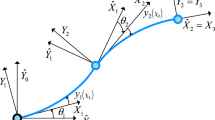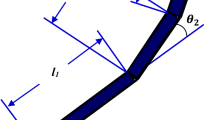Abstract
This paper addresses the implementation of an adaptive fuzzy controller for flexible link robot arms. The design technique is a hybrid scheme involving both frequency and time domain techniques. The eigenvalues of the open loop plant can be estimated through application of a frequency domain based identification algorithm. The region of the eigenvalue space, within which the system operates, is partitioned into fuzzy cells. Membership function are assigned to the fuzzy sets of the eigenvalue universe of discourse. The degree of uncertainty on the estimated eigenvalues is encountered through these membership functions. The knowledge data base consists of feedback gains required to place the closed loop poles at predefined locations. A rule based controller infers the control input variable weighting each with the value of the membership functions at the identified eigenvalue. The afore-mentioned controller is compared through simulation with conventional techniques, namely pole placement and gain scheduling.
Similar content being viewed by others
Explore related subjects
Discover the latest articles, news and stories from top researchers in related subjects.References
Daley, S. and Gill, K. F.: Comparison of a fuzzy logic controller with aP +D control law,ASME Dynamic Sys. Meas. Control 111 (1989), 128–137.
Dote, Y.: Stability analysis of variable-structured PI controller by fuzzy logic for servo system, inProc. IEEE Conf. Decision and Control, Brighton, England, December 1991, pp. 1217–1218.
Kiska, J. B., Gupta, M. M., and Nikiforuk, P. N.: Energistic stability of fuzzy dynamic systems,IEEE Trans. Systems Cybernet. 4(5) (1985), 783–792.
Kang, H. and Vachtsevanos, G.: Model reference fuzzy control, inProc. IEEE Conf. Decision and Control, Tampa, FL, December 1989, pp. 751–756.
Lee, C. C.: Fuzzy logic in control Systems: fuzzy logic controller, Part I,IEEE Trans. Systems Man Cybernet. 20(2) (1990), 404–418.
Lee, C. C.: Fuzzy logic in control systems: fuzzy logic controller, Part II,IEEE Trans. Systems Man Cybernet. 20(2) (1990), 419–435.
Mamdani, E. H.: Application of fuzzy algorithms for simple dynamic plant,Proc. IEE, Part D121(12) (1974), 1585–1588.
Paraskevopoulos, P. N.: On the pole assignment by proportional plus derivative output feedback,Electronic Lett. 14 (1976), 34–35.
Pedrycz, W.: An approach to the analysis of fuzzy systems,Internat. J. Control 34(3) (1981), 403–421.
Rutherford, D. A. and Bloore, G. C.: The implementation of fuzzy algorithms for control,Proc. IEEE 64(4) (1976), 572–573.
Ray, K. S. and Majumber, D. D.: Application of stability criteria for stability analysis of linear SISO and MIMO systems associated with fuzzy logic controller,IEEE Trans. Systems Man Cybernet. 3(2) (1984), 345–349.
Shynk, J. J.: Adaptive IIR filtering,IEEE ASSP Magazine 6(2) (1989), 4–21.
Tang, K. L. and Mulholland, R. J.: Comparing fuzzy logic with classical controller designs,IEEE Trans. Systems Man Cybernet. 17(6) (1987), 1085–1087.
Takagi, T. and Sugeno, M.: Fuzzy identification of systems and its applications to modeling and control,IEEE Trans. Systems Man Cybernet. 15(1) (1985), 116–132.
Tzes, A. and Yurkovich, S.: A frequency domain identification scheme for flexible structure control,Trans. ASME J. Dyn. Meas. Control 112 (1990), 427–434.
Tzes, A. and Yurkovich, S.: An adaptive input shaping control scheme for vibration supression in slewing flexible structures,IEEE Trans. Control Systems Technol. 1 (June 1993).
Tzes, A.:Self-tuning controllers for flexible link manipulators, PhD thesis, The Ohio State University, 1990.
Wang, B. H. and Vachtsevanos, G.: Fuzzy logic control: A systematic design methodology, inProc. IEEE Conf. Decision and Control, Brighton, England, December 1991, pp. 1219–1220.
Zadeh, L. A.: Fuzzy sets as a basis for a theory of possibility,Fuzzy Sets Systems 1(1) (1978), 3–28.
Author information
Authors and Affiliations
Rights and permissions
About this article
Cite this article
Tzes, A., Kyriakides, K. A hybrid frequency—time domain adaptive fuzzy control scheme for flexible link manipulators. J Intell Robot Syst 10, 283–300 (1994). https://doi.org/10.1007/BF01258262
Received:
Accepted:
Issue Date:
DOI: https://doi.org/10.1007/BF01258262




